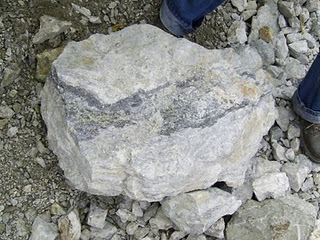Some characteristic features of type ore mineral type
Gold nuggets with large size of more than 2mm. And the Nuggets usually have a 20K or pure gold content of 83% to 92% or it could be up to 23K. And this nugget of gold usually has shades of orange yellow color. The formation of naturally occurring surface oxide layer that inhibits adhesion between the gold flakes. So when gold pieces collide with each other under pressure, they may be joined into larger sections. Another nugget may occur in the form of the original vein prior to erosion, often showing signs of abrasive polishing due to the flow. For many gold nuggets found in outcrop or in a deposit of placer gold veins or lodes that have been weathered. Gold nuggets are also many who find the prospect of the river area where the area has a metal mineral content is very high.
 Free gold with fine grains and has a size less than 2mm to 150 microns and can be seen with the eye naked without using binoculars or a microscope. Characteristics of gold is similar to the gold nuggets. Many miners who discovered free gold in a watershed. And they are often found in large numbers. Absorption method simply by panning or using a centrifuge to separate the gold grains of the mineral carrier. Gold grains are often found in deposits in primary or secondary deposits.
Free gold with fine grains and has a size less than 2mm to 150 microns and can be seen with the eye naked without using binoculars or a microscope. Characteristics of gold is similar to the gold nuggets. Many miners who discovered free gold in a watershed. And they are often found in large numbers. Absorption method simply by panning or using a centrifuge to separate the gold grains of the mineral carrier. Gold grains are often found in deposits in primary or secondary deposits.Specimens of gold which is a form of gold with a mineral carrier or quartz and has a size of metallic ore which is almost the same as free gold. Where the gold grains are visible with the naked eye either intergrown with gangue in primary deposits or as a loose item in secondary deposits. For the separation of metals with mineral carrier we could use the machines to separate the gold grains from the unwanted gangue. Fortunately, a high density of gold allows for effectively separated and concentrated using gravity method with low costs, such as jigs, water gate, shaking tables etc.
Where the size of microcrystalline gold ore minerals are below 150 microns to 0.8 microns and fatherly look of metal ore we need a tool microscope. Microcrystalline gold deposits are generally found in the primary. Gold grains are disseminated in a gangue of quartz and intergrown or locked in sulfide minerals. Coarse grains can be liberated by crushing and grinding followed by gravity concentration using a concentrator. If the ore consists of very fine grains extraction with a mixture of sodium cyanide to extract metal ore fatherly.
Submicro crystalline gold particles and typically occur in the crystal lattice of certain sulfide ores. Gold contained in sulfide minerals present as small grains and particles in the crystal lattice of minerals. Many primary deposit consists of grains and disseminated in pyrite, chalcopyite, arsenopyrite or pyrrhotite containing large amounts of gold and intergrown with gangue minerals. Sulfide minerals can not be concentrated by gravity methods because the gravity is very low for gold sulfide. Froth flotation is the most common technique used to process the content of ore minerals in these rocks, followed by using sodium cyanide to remove gold. Mining techniques such methods are expensive and can only be used on large deposits, but has a low value to support the processing activities.
Gold in some tellurium compounds. Gold also occurs in a gold or silver compounds witht ellurium. Tellurium can sometimes be found in nature, but more often as a compound tellurida of gold (kalaverit), and joined with other metals. Most elements of tellurides compounds found in rock type and sylvanite calaverite. However, this compound is extreme lyrare for the content of gold in a mine. Tellurium obtained commercially from the anode mud produced during electrolysis of copper refining process heat.
All types of gold formation above the main establishment on the basis of natural events That shape and size of gold ore minerals ore minerals. Of all types of gold ore minerals all show varying degrees of crystallinity of spherical grains (eg alluvial) crystal with sub hedral grains without visible through the crystal with the ultimate appearance of the hydrothermal process. In most Situations, gold was found in a round shape, however, where the crystallisation of open space has occurred, Such as in the supergene environment, gold is the most common crystal.








